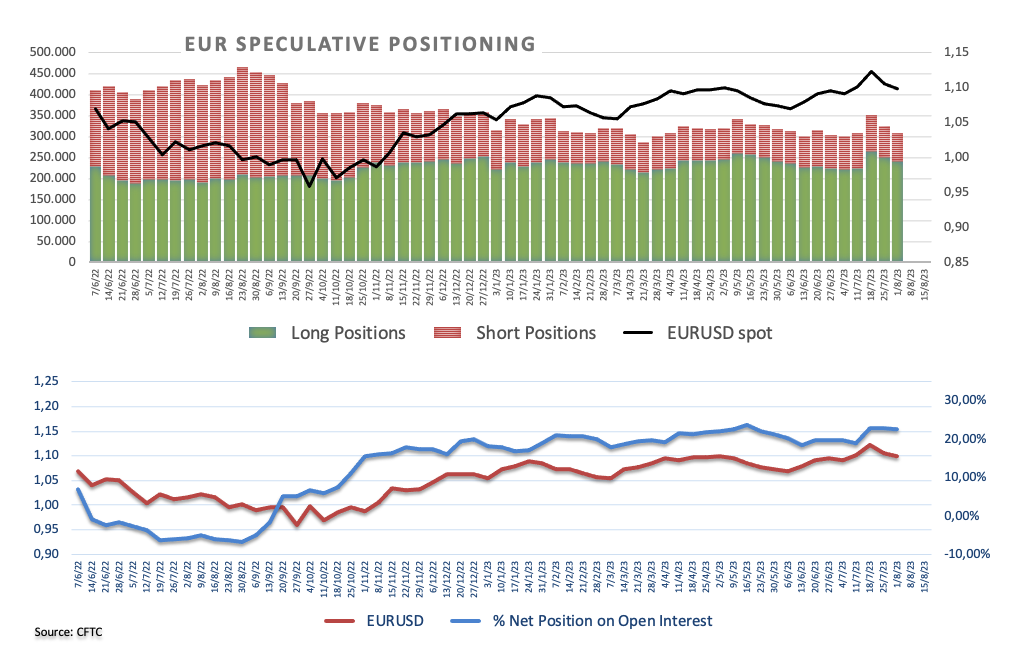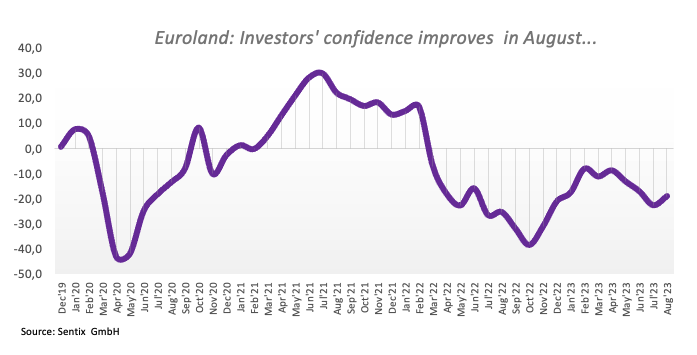Euro appears so far propped up by the 1.0910 region

- Euro leaves behind part of recent gains vs. the US Dollar.
- Stocks in Europe extend the negative start of the week.
- EUR/USD recedes to the vicinity of 1.0960 on Fed, risk-off mood.
- The USD Index (DXY) regains the area above 102.00.
- Industrial Production in Germany contracted 1.5% MoM in June.
- EMU’s Investor Confidence improved in August.
The Euro (EUR) kicked off the week with a tendency to decline against the US Dollar (USD). As a result, EUR/USD broke below the significant 1.1000 level following two consecutive days of gains on Monday.
Conversely, the Greenback gained momentum after experiencing two back-to-back days of declines. It managed to surpass the 102.00 mark when measured by the USD Index (DXY), driven partly by investors analyzing the recent release of Nonfarm Payrolls data (+187K) from Friday.
Regarding the latter point, it’s important to note that even though the US economy generated fewer jobs than initially predicted, the stability of wage growth and an improved jobless rate of 3.5% suggest that the labor market’s resilience remains mostly intact.
Apart from the prevailing risk-averse sentiment in the market, the renewed bullish bias in the US Dollar can be attributed to statements made by Michelle Bowman of the FOMC. She suggested the possibility of further interest rate hikes (perhaps in the upcoming meeting) if deflationary pressures lose traction.
This stance contradicts the prevailing speculation that the Fed’s rate hike in July could have been its final one in the near future. Furthermore, the likelihood of the European Central Bank (ECB) implementing additional tightening measures beyond the summer seems to be losing its strength.
From the speculative community, EUR net longs receded a tad to three-week lows just above 172K contracts in the week to August 1 according to CFTC’s report. Under that period, spot saw its decline accelerate in the wake of the FOMC and ECB interest rate decisions on July 26 and July 27, respectively.
In the euro docket, Industrial Production in Germany contracted 1.5% MoM in June and 1.8% over the last 12 months. In addition, Investor Confidence tracked by the Sentix index improved to -18.9 for the month of August.
In the US, Consumer Credit Change will be the sole release along with short-term bill auctions.
Daily digest market movers: Euro remains offered in the sub-1.1000 area
- The EUR meets initial support near 1.0960 vs. the USD on Monday.
- The USD Index (DXY) retakes the 102.00 hurdle and beyond.
- Risk aversion kicks in at the beginning of the new week.
- Fed’s Bowman did not rule out extra tightening in the near term.
- CME Group’s FedWatch Tool sees no rate hikes by the Fed in H2 2023.
- Speculation that the Fed might have ended its hiking cycle remains steady.
- Investors’ focus is expected to shift to US inflation figures (August 11).
Technical Analysis: Euro needs to clear 1.1150 to mitigate the selling pressure
EUR/USD comes under renewed downside pressure and breaches the key psychological support at 1.1000.
The loss of the 1.0920 region, where the provisional 55-day and 100-day SMAs converge, leaves EUR/USD vulnerable to a probable drop to the July low of 1.0833 (July 6) ahead of the key 200-day SMA at 1.0748 and the May low of 1.0635 (May 31). South from here emerges the March low of 1.0516 (March 15) before the 2023 low of 1.0481 (January 6).
On the other hand, occasional bullish attempts could motivate the pair to initially dispute the weekly top at 1.1149 (July 27). Above this level, the downside pressure could mitigate somewhat and could encourage the pair to test the 2023 high at 1.1275 (July 18). Once this level is cleared, there are no resistance levels of significance until the 2022 peak of 1.1495 (February 10), which is closely followed by the round level of 1.1500.
Furthermore, the constructive view of EUR/USD appears unchanged as long as the pair trades above the key 200-day SMA.
German economy FAQs
The German economy has a significant impact on the Euro due to its status as the largest economy within the Eurozone. Germany’s economic performance, its GDP, employment, and inflation, can greatly influence the overall stability and confidence in the Euro. As Germany’s economy strengthens, it can bolster the Euro’s value, while the opposite is true if it weakens. Overall, the German economy plays a crucial role in shaping the Euro’s strength and perception in global markets.
Germany is the largest economy in the Eurozone and therefore an influential actor in the region. During the Eurozone sovereign debt crisis in 2009-12, Germany was pivotal in setting up various stability funds to bail out debtor countries. It took a leadership role in the implementation of the ‘Fiscal Compact’ following the crisis – a set of more stringent rules to manage member states’ finances and punish ‘debt sinners’. Germany spearheaded a culture of ‘Financial Stability’ and the German economic model has been widely used as a blueprint for economic growth by fellow Eurozone members.
Bunds are bonds issued by the German government. Like all bonds they pay holders a regular interest payment, or coupon, followed by the full value of the loan, or principal, at maturity. Because Germany has the largest economy in the Eurozone, Bunds are used as a benchmark for other European government bonds. Long-term Bunds are viewed as a solid, risk-free investment as they are backed by the full faith and credit of the German nation. For this reason they are treated as a safe-haven by investors – gaining in value in times of crisis, whilst falling during periods of prosperity.
German Bund Yields measure the annual return an investor can expect from holding German government bonds, or Bunds. Like other bonds, Bunds pay holders interest at regular intervals, called the ‘coupon’, followed by the full value of the bond at maturity. Whilst the coupon is fixed, the Yield varies as it takes into account changes in the bond’s price, and it is therefore considered a more accurate reflection of return. A decline in the bund’s price raises the coupon as a percentage of the loan, resulting in a higher Yield and vice versa for a rise. This explains why Bund Yields move inversely to prices.
The Bundesbank is the central bank of Germany. It plays a key role in implementing monetary policy within Germany, and central banks in the region more broadly. Its goal is price stability, or keeping inflation low and predictable. It is responsible for ensuring the smooth operation of payment systems in Germany and participates in the oversight of financial institutions. The Bundesbank has a reputation for being conservative, prioritizing the fight against inflation over economic growth. It has been influential in the setup and policy of the European Central Bank (ECB).

